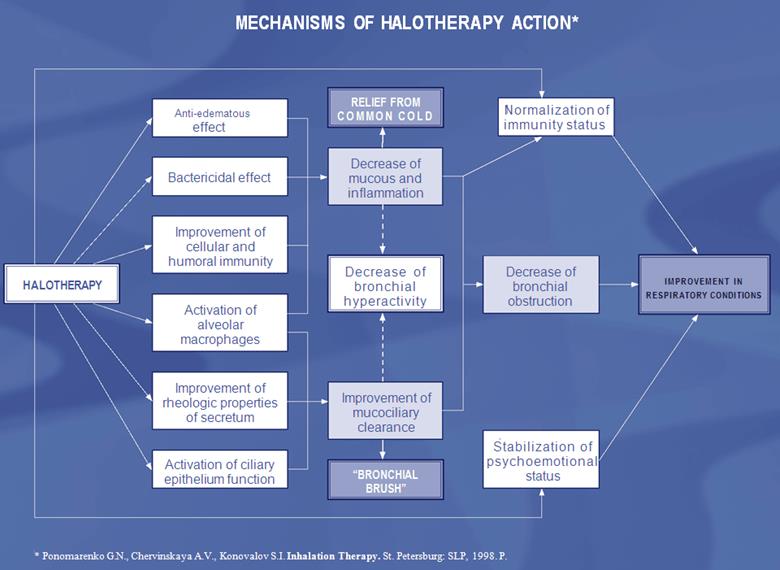Halochambers
Our halochambers, or salt rooms, are specially designed to enhance breathing, skin appearance and mood. The walls and the floor are covered in salt. The salt covering is decoration, but also has practical functions. It assists in maintaining temperature, humidity and hypobacterial conditions, and absorbs sound. The salt on the walls and floor also lend negative ions to the room.
The halochambers have a stable humidity (relative air humidity 40-60%) and stable air temperature (65-73°F). These parameters create comfortable conditions for patients and promote a stable aerosol environment. A stable hypoallergenic, hypobacterial environment is maintained in the therapeutic room as well. The assessment of microbial contamination during a session of Halotherapy proves that 1m3 contains from 90 – 200 saprophytic microorganisms (according to WHO standards on air sterility, 1m3 should contain less than 300 microbial bodies). Microflora content returns to its initial level 10-20 minutes after the session is completed.
The white salt environment in combination with comfortable zero gravity chairs, soft illumination and fresh pure air create a quiet, peaceful atmosphere where people can relax and get away from their daily worries and cares.
How does the technology work?
Our halochambers are equipped with state of the art Halomed Halogenerators designed by Dr. Alina Chervinskaya, the leading expert in Halotherapy who has worked in the field of preventative, restorative, and rehabilitative medicine, pulmonology, and physiotherapy for over 20 years. The halogenerators, a specialized nebulizer, grind pharmaceutical grade dry sodium chloride into aerosol particles of 1-5 μm in size. The halogenerator is situated in an interconnecting room and brings a flow of clean, dry air, saturated with highly dispersed negatively charged particles of sodium chloride into the therapeutic room. The halogenerator has a microprocessor that monitors and maintains the temperature, relative humidity and mass concentration of aerosol in the chamber. The concentration of dry salt aerosol can be adjusted to the most beneficial concentration for a certain condition. For example, someone with cystic fibrosis or psoriasis would get better results with a higher concentration of salt than is necessary to treat allergies or COPD. After each therapy session, air in the room is completely vented and new air is pumped into the room in preparation for a new treatment session.
Halotherapy Standards
Salt therapy is new to the US. How do you know that the therapy you receive is truly beneficial? Not all salt rooms are the same. A therapeutic salt room requires the proper equipment, layout, and proper materials.
Proper technology:
-Therapeutic levels of salt must be driven by a Halogenerator (dry salt aerosol generator) with the ability to control both concentration of the salt in the air and breathable particle size. Particles larger than 5 microns do not penetrate into the lungs where the action is needed.
-Proper design of heating, ventilation and humidification systems of the Halotherapy center.
-The treatment room and technical room must be separate from other parts of the clinic.
-Treatment room size must be appropriate with the Halogenerator aerosol output.
Equipment–Halogenerator:
-Just having a salt covering on the walls and floor is not the source of therapeutic salt. For creation of the therapeutic microclimate you must have the proper amount of dry salt aerosol which can be only be produced by a special device – a Halogenerator (dry salt aerosol generator)
-Halogenerators of many salt rooms give a constant output of salt. To be therapeutic, there should be a sensor device than can analyze that amount of salt in the room and adjust to maintain the necessary level for effective treatment and health improvement.
-Inhaling too much salt aerosol during a therapy session can be dangerous and cause bronchospasm and other side effects. Some clinics use devices that produce aerosol from water based saline solution for inhalation during treatments and call this Halotherapy. In many cases such clinics use humidifiers filled with salt solution instead of water. Research shows that humid aerosol is not as effective as dry salt aerosol. Moreover, many people feel discomfort in a humid salt fog and there is danger of side effects for some people.
Proper design of heating, ventilation and humidification systems:
-Deliver fresh air into the salt room.
-Keep a positive difference of the pressure between a salt room and neighboring rooms.
-Maintain a comfortable microclimate in the salt room (temperature, relative humidity, cleanliness , air currents.)
-Remove viruses and bacteria, the products of human metabolism after each session (complete multiple air replacement in the room between sessions.)
-Inappropriate design of heating and humidification systems reduces the efficiency of Halotherapy treatments. Inappropriate design of the ventilation system may lead to microbial cross-contamination.
Untreated sodium chloride must be used for salt aerosol generation only:
Some clinics promote the use of Himalayan and Dead Sea salt in their halogenerators claiming that they contain minerals that are beneficial. However, you never know what you are getting as the concentration is not constant in the salt crystals. They also will contain clay, mud, soil and other impurities that could cause allergic reactions and other side effects. Only pharmaceutical grade sodium chloride is clinically proven for inhalation and use for Halotherapy treatments.


